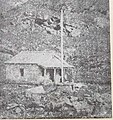Gurdwara Hemkund Sahib
Gurudwara Hemkund Sahib | |
|---|---|
Town | |
UTC+5:30 (IST) | |
| PIN | 249401 |
| Vehicle registration | UK 11 |
| Website | shrihemkuntsahib.com |
Gurdwara Hemkund Sahib is a
Etymology
Hemkund is a Sanskrit name derived from Hem ("Snow") and Kund ("bowl"). The Dasam Granth says that in a former life, Guru Gobind Singh meditated intensely at Hemkund on Akaal.[5]

Travel

Hemkund is inaccessible from October through April because of snowbound paths and glaciers. Sikh pilgrims arrive in May and set to work to repair the damage to the path over the winter, which tradition is called kar seva ("selfless service"), a concept which forms an important tenet of the Sikh faith.
The take-off point for Hemkund Sahib is the town of
From Delhi, tourists take the train to Haridwar and then travel by bus to Govindghat via Rishikesh. It is also possible to drive from Delhi to Govindghat, a distance of about 500 kilometres (310 mi) which takes around 18 hours to cover. Recently, an Indian airline company has started a helicopter service between Govindghat and Ghangria. The flight takes about 5 minutes.

A recent study examining
Present Gurudwara

Design and construction of the present gurudwara at Hemkund was started in the mid-1960s, after Major General Harkirat Singh, KCIO, Engineer-in-Chief, Indian Army visited the gurudwara. The engineering brain behind the Gurudwara project, Major General Harkirat Singh selected Architect Manmohan Singh Siali of the Military Engineering Services (MES) to head the design and construction effort. Thereafter, Architect Siali made annual trips to Hemkund Sahib and organized and supervised complex construction. M/s Sahib Singh, Harbhajan Singh & Gursharan Singh were the dedicated Gursikh contractors who worked on the construction, overcoming numerous weather, altitude, terrain, and logistic challenges. The unique design and construction are acclaimed as marvels, both of which have borne the test of sustainability over the past many decades.
Valley of Flowers
About 3 kilometres (1.9 mi) from Gobinddham is the 5-kilometre (3.1 mi) long Valley of Flowers. The Indian Government has declared this valley a national park. It is situated in
Gallery
- Views of Hemkund (Hemkunt) Sahib
-
Photograph of Gurdwara Hemkunt Sahib in 1936, the year the first Gurdwara was established (pictured)
-
Photograph of a group of Sikh pilgrims praying at Gurdwara Hemkunt Sahib in 1960
-
Gurudwara in front of lake
-
Gurdwara Hemkunt Sahib
-
Brahmkamal
References
- ^ "52nd REPORT OF THE COMMISSIONER FOR LINGUISTIC MINORITIES IN INDIA" (PDF). nclm.nic.in. Ministry of Minority Affairs. Archived from the original (PDF) on 25 May 2017. Retrieved 9 October 2019.
- ^ "Garhwali". Ethnologue. Retrieved 24 February 2021.
- ^ "Hemkund Sahib | Chamoli District Website | India". Government of Uttarakhand. Retrieved 24 September 2023.
- ^ Hemkunt Sahib at Google maps Satellite view: lake, Gurudwara building on the west shore, zigzag pilgrim path from Ghanghariya (2 km west) to west shore. Terrain view: Hemkund Sahib at 4,160 m, Ghanghariua at 3,100 m.
- PMID 24082642.
- ^ Gurudwara Sri Hemkunt Sahib: The Design and Architecture. shrihemkuntsahib.com
Further reading
- Gurdwara in the Himalayas: Sri Hemkunt Sahib, by Suparna Rajguru, M. S. Siali. Published by Hemkunt, 2001. ISBN 81-7010-292-8.
- Pilgrimage to Hemkunt, by Jaswant Singh Neki. Photographs by Sondeep Shankar. New Delhi, UBSPD, 2002, ISBN 81-7476-375-9.
External links
- Hemkund Sahib Yatra Information
- HemKund Sahib Road Map
 Gurdwara Hemkund Sahib travel guide from Wikivoyage
Gurdwara Hemkund Sahib travel guide from Wikivoyage- Facebook Page





